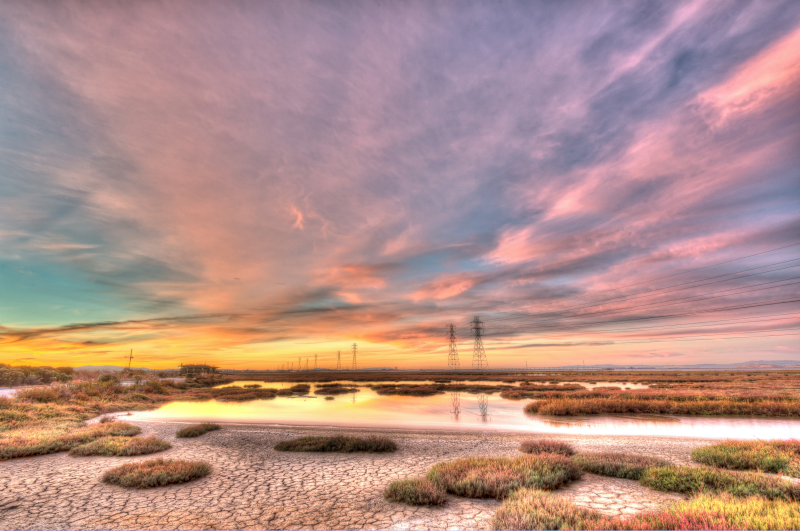Adapting to a Changing Climate
Climate Impacts in Sunnyvale, 2070-2099
While certain climate impacts may be felt more locally, climate change is a regional and global issue that must be addressed on a regional scale. For example, water from sea-level rise-related flooding will find the lowest point regardless of jurisdictional boundaries. The City of Sunnyvale sees climate change as an area where collaboration with regional entities (like Valley Water and the United States Army Corps of Engineers) is essential to making progress.
Adapting to a Changing Climate
Other Impacts
Climate change is already changing the weather patterns we have grown accustomed to, and these changes are projected to continue. Both the rate and intensity of wildfires in California are expected to increase. We could see a 55% increase in the number of wildfires by 2050. Rising temperatures are driving species further north, disrupting water and food supplies, degrading soil health, and negatively affecting aquatic life. Heat waves are also causing public health issues by worsening air quality, increasing vector-borne diseases, and causing heat-related illnesses.
Play 6.1: Assess Climate Vulnerabilities for Sunnyvale
Climate Adaptation
To prepare for climate change, cities in the region must work together. As a region, we can efficiently address risks and avoid harming nearby communities. In 2015, Santa Clara County brought together cities countywide to assess the impacts of sea level rise, flooding, wildfire and extreme heat. The County developed an assessment tool known as Silicon Valley 2.0. Explore the tool to see how climate change can impact different locations Sunnyvale. The City will continue to join regional discussions and work with key partners on adaptation efforts.
Play 6.2: Protect Shoreline Area from Sea Level Rise and Coastal Flooding
Shoreline Protection
Valley Water began the Shoreline Protection Project in 2005 to provide sea level rise protection in Santa Clara County. The project is with the United States Army Corps of Engineers (USACE) and the State Coastal Conservancy (Conservancy).
Valley Water also prepared a Preliminary Feasibility Study for the shoreline areas next to Sunnyvale. Sunnyvale staff will continue to advocate for a project to protect Sunnyvale’s shoreline.
Play 6.2: Protect Shoreline Area from Sea Level Rise and Coastal Flooding
Updating Our Plans
The Moffett Park Specific Plan was adopted in 2004 to provide direction on land use, infrastructure, and design in the northernmost portion of the city, which is mainly commercial and industrial. This part of the City is located right along the Bay and is vulnerable to sea level rise. In 2023, the Sunnyvale City Council adopted an updated Moffett Park Specific Plan (MPSP). The updated plan considers the economic impacts of adding new housing, improves non-automotive transportation, promotes walkable and bikeable environments, creates an eco-innovation district, and prepares an implementation strategy for infrastructure and services.
Play 6.3: Strengthen Community Resiliency
What is Climate Resiliency?
Climate change is bringing more frequent and more severe climate hazards, such as extreme heat, wildfires, and sea level rise. Climate resilience speaks to the ability of a community to prepare for, absorb, recover from, and adapt to climate hazards. The City will focus on short-term preparedness measures our community can take to resist climate impacts while simultaneously identifying key future vulnerabilities and strategies to address them in the coming years.
Play 6.3: Strengthen Community Resiliency
Emergency Preparedness
The City has emergency response plans for some events like fires and earthquakes. The City is committed to developing community-oriented emergency preparedness plans to respond to these events. In April 2024, the Severe Weather Annex to the Emergency Operations Plan (EOP) was completed. This update details procedures for responding to severe weather events, such as heat events, air quality issues, and flooding. Existing and new plans will pay particular attention to vulnerable populations during natural disasters. Stay informed with Sunnyvale’s emergency preparedness resources.
Play 6.3: Strengthen Community Resiliency
Community Resilience Plan
The City will develop a community resilience plan to help all residents and businesses be prepared to weather the storms of climate change. Vulnerable populations, such as elderly, disabled, or low-income residents, will be given special consideration. With careful planning, our community will become more resilient to extreme heat, rain, and flooding events.
Be Part of the Solution
Preparedness is Key
Climate change is creating conditions for sudden emergencies like wildfires as well as long term shifts to warmer and drier conditions. Being prepared for both will help make sure our community continues to thrive in the face of change.

